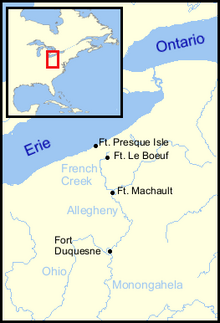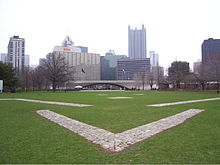Fort Duquesne
| Fort Duquesne | ||
|---|---|---|
|
|
||
| Location: | Pennsylvania , United States | |
| Next city: | Pittsburgh | |
| Surface: | 0.9 km² | |
| Founding: | July 3, 1754 | |
| Visitors: | 744,971 (2008) | |
| Map of Fort Duquesne around 1754 | ||
Fort Duquesne , originally Fort Du Quesne, later replaced by Fort Pitt , was an 18th century fortification on what is now the city of Pittsburgh in the state of Pennsylvania .
It was at the point where the Monongahela River and the Allegheny River converge and form the Ohio River (so-called Forks of the Ohio ). During the French and Indian War ( Seven Years War in North America ) (1754–1763) Fort Duquesne was of great strategic importance and changed hands several times.
In the 1740s, William Trent , a British fur trader and entrepreneur, built a small trading post in the area that would later become the fort. Trent became prosperous through trade with the neighboring Indian tribes . The French noticed the British presence in an area they claimed and strategically important and began building a number of forts in the area in the early 1750s ( Fort de la Presqu'île , Marchault ( Venango ) and Le Boeuf ).
Robert Dinwiddie , governor of the British colony of Virginia and an active land speculator, responded to this threat by building a fort - in the middle of the jungle - at the confluence of the Monongahela and Allegheny , the location of which had been suggested by George Washington , then a young militia officer . In April 1754, Virginia soldiers began construction on Fort Prince George but were driven out by superior French forces. The French finished building the fort and named it Fort Duquesne after Ange de Menneville, Marquis de Duquesne , the governor-general of New France ( Canada ).
In its first attempt to regain Fort Duquesne, Washington engaged in a successful skirmish with French troops (known as the Jumonville Affair ), but was forced to face the vastly outnumbered French reinforcements in the small palisade fortress that it had built, Fort Necessity , on Nov. July 1754 surrender against free withdrawal. Another attempt to retake Fort Duquesne, this time with regular troops under the command of Major General Edward Braddock (Braddock Expedition), led to a severe British defeat on July 9, 1755 in the Battle of Monongahela . Three years later, General John Forbes concentrated no fewer than 6,000 men in Fort Cumberland , western Maryland . This army included a contingent of 2,000 Virginia militiamen under the command of George Washington. The route to the sparsely occupied Fort Duquesne was controversial. Washington made a strong case for the road built for the unfortunate Braddock expedition of 1755. Others, including those with business interests in Pennsylvania, called for a road to be built through the central part of that province. Forbes finally decided on the second solution.
The advance on the newly built road was extremely slow, which is why Washington feared that Fort Duquesne would receive reinforcements. Forbes sent a reconnaissance team under Major James Grant, which was discovered by the French due to Grant's amateurish leadership and destroyed on September 14th. Some of the Scottish soldiers were allegedly beheaded and their heads were placed on stakes at the fort. There is no evidence for this. Initially, Forbes decided to postpone the offensive until the coming year due to increasingly bad weather, but Washington soldiers managed to capture some enemy scouts. From these the British learned that the fort was only sparsely occupied and that the Indian allies would desert in large numbers. A peace treaty that Forbes had signed with the Indian tribes of the region in Fort Bedford had contributed to this. Washington then ordered an immediate advance.
On November 24th, the French commander of Fort Duquesne saw the untenability of his situation - his Indian allies deserted him and he was cut off from French support from Canada by the fall of Fort Frontenac . So the French abandoned the fort, set it on fire, and rafted to safety across the Ohio. A day later, the British occupied the smoking ruins. A force stayed on site and began rebuilding the fortification, which was named Fort Pitt after the British Foreign and War Minister and later Prime Minister William Pitt . Together with the conquest of Fort Frontenac and the fortress Louisbourg on Cape Breton Island , the fall of Fort Pitt represented a turning point in the war. This did not go unnoticed by the Indian allies of the French, who now belong to their previous comrades in greater numbers started leaving.
Fort Pitt gained great military importance again as early as 1763, when it was successfully defended against an attack by the insurgent Lenni Lenape on June 22nd during the Pontiac uprising by its 330-man garrison under Captain Simeon Ecuyer and also resisted a siege. Up to 600 settlers who had fled from the Indians stayed in the fort. Fort Pitt was, besides Detroit, the only British fortification beyond the Appalachians that was not conquered by the Indians. The attempt to decimate the Indians with ceilings contaminated with smallpox , a procedure proposed by General Jeffrey Amherst , shows how dangerous the situation was for the British . This is arguably the first and otherwise unsuccessful attempt at biological warfare in America. A later outbreak of the disease had other causes. An expeditionary force under Colonel Henry Bouquet defeated the besiegers on August 5th and 6th in the battle of Bushy Run and reached Fort Pitt on August 20th.
In the early 1770s the fort was named Fort Dunmore in honor of the Governor of New York , but was given its name back during the American Revolutionary War . The settlement around the fort was named Pittsburgh and rapidly developed into a large city from around 1790 after the end of the War of Independence. The fort itself was demolished after losing its military function. A bastion of the fort was rebuilt and is now the site of the Fort Pitt Museum , which documents the early history of Pittsburgh during the colonial era.
literature
- George Dallas Albert: The Frontier Forts of Western Pennsylvania . CM Busch, Harrisburg 1896. (Vol. II of Report of the Commission to Locate the Site of the Frontier Forts of Pennsylvania. )
Web links
Individual evidence
- ^ The Battle of the Monongahela . 1755. Retrieved August 5, 2013.
- ^ David Dixon: Never come to peace again . University of Oklahoma Press, 2005, ISBN 978-0-8061-3656-1 , 154



